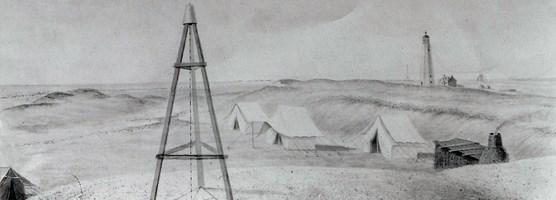
Pre-Lighthouse Era on Fire Island: 1783-1824 Fire Island was part of this shoreline, one in a series of gently sloping barrier beaches. With offshore sandbars lying six to nine feet below the surface and about a quarter mile from the shoreline, this area could be treacherous for ships. Most shipwrecks off the southern coast of Long Island hit the sandbar and snapped their masts. The rise and fall of the sea could then destroy their hull. Approximately 200 known and an estimated 640 unidentified ships wrecked off the coast of Fire Island since the mid-1600s. On August 7, 1789, the federal government assumed jurisdiction over lighthouses, which had previously been administered separately by the states. Lighthouses were not present along the coast of Long Island prior to the change in jurisdiction. The Montauk Point Lighthouse, constructed on the easternmost tip of Long Island in 1797, was the first federally funded lighthouse in the country and was the first of several lighthouses that would guide ships along the coastline into New York Harbor. The Fire Island Light, placed into service in 1826, was the second lighthouse along the coast of Long Island. First Fire Island Lighthouse: 1825 - 1858 The Second Lighthouse is Constructed: 1857-1858 This original first order Fresnel lens served as a beacon to mariners from the top of the Fire Island Lighthouse from 1858 through 1932. In 1933, it was taken out of service and displayed at the Franklin Institute in Philadelphia until 2000. 
The Fire Island Lighthouse Preservation Society FILPS is authorized as a fundraising partner to support maintenance and improvements at the Fire Island Lighthouse, and since 2005 has raised more than $500,000 for the construction of the new building to display and interpret Fire Island's original first order Fresnel lens. Learn More

Original artwork created by Steve Harrington for National Park Service. .The 1858 Fire Island Lighthouse was originally a cream color. It didn't get its distinctive black and white daymarks until 1892. |
Last updated: April 13, 2018
